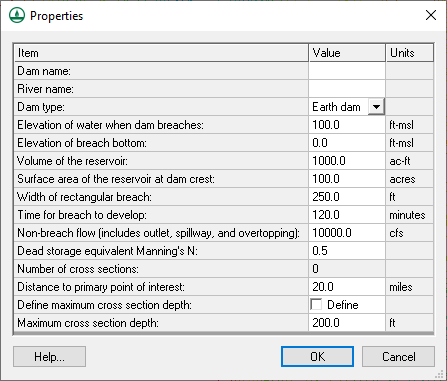WMS:SMPDBK
The Simplified Dam-Break (SMPDBK) was developed by the National Weather Service (NWS) for predicting downstream flooding produced by a dam failure. This program is still capable of producing the information necessary to estimate flooded areas resulting from dam-break floodwaters while substantially reducing the amount of time, data, and expertise required to run a simulation of the more sophisticated unsteady NWS DAMBRK, or now called FLDWAV. The SMPDBK method is useful for situations where reconnaissance level results are adequate, and when data and time available to prepare the simulation are sparse. Unlike the more sophisticated versions of DAMBRK and FLDWAV, the SMPDBK method does not account for backwater effects created by natural channel constrictions of those due to such obstacles as downstream dams or bridge embankments.
The input required for a SMPDBK model is a stream centerline, cross sections, and information regarding the storage and failure of the dam being modeled. WMS saves the model data to a properly formatted input file for SMPDBK and then launches the executable. The executable is the same version distributed by the NWS. When a model is successfully run, WMS will automatically read the results and create a water surface elevation data set that can be used for automated floodplain delineation as illustrated in the picture below.
SMPDBK Dam Properties
The Dam Properties dialog (from Edit Parameters of the SMPDBK menu) is used to set several options which describe the dam. This dialog is pictured below.
Data for this dialog can be collected by searching for the data on the Internet. Data could also be obtained from the National Inventory of Dams web site at http://geo.usace.army.mil/pgis/f?p=397:1:0 (2004).
Running a Simulation
The SMPDBK executable is distributed with WMS and should be present in the WMS program directory (SMPDBK.EXE). When choosing the Run Simulation command you will be prompted for a file name that WMS will use to write the properly formatted input based on the centerline, cross section, roughness, and dam properties defined. After writing the input file WMS will launch the SMPDBK executable and pass the newly created input file as a command line argument.
Related Topics
- Centerline
- Cross Sections
- Defining Roughness
- Dam Properties
- Running a Simulation
- Post Processing
- Automated Floodplain Delineation
WMS – Watershed Modeling System | ||
|---|---|---|
| Modules: | Terrain Data • Drainage • Map • Hydrologic Modeling • River • GIS • 2D Grid • 2D Scatter |  |
| Models: | CE-QUAL-W2 • GSSHA • HEC-1 • HEC-HMS • HEC-RAS • HSPF • MODRAT • NSS • OC Hydrograph • OC Rational • Rational • River Tools • Storm Drain • SMPDBK • SWMM • TR-20 • TR-55 | |
| Toolbars: | Modules • Macros • Units • Digitize • Static Tools • Dynamic Tools • Drawing • Get Data Tools | |
| Aquaveo | ||
